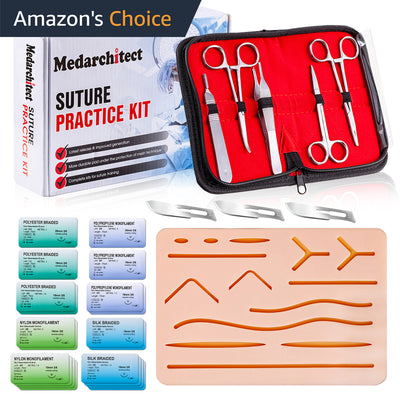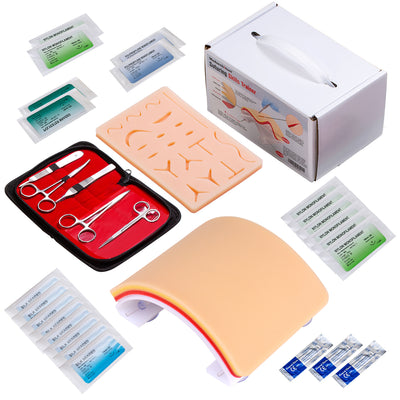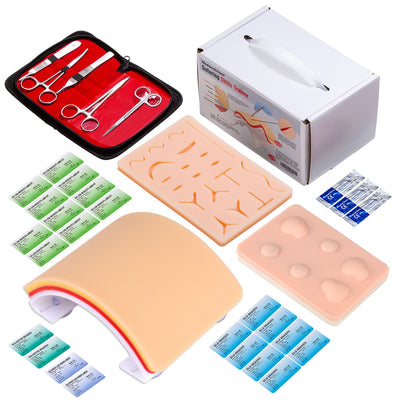In battlefield medicine, emergency training, or trauma simulation courses, not all gunshot wounds are the same. The size and energy of a bullet can drastically change the type of injury—and how it should be treated.
Whether you're a medical student, TCCC trainee, or emergency responder, this guide will help you understand the key differences between 5.56mm, 7.62mm, and 9mm bullet wounds, and how to choose the right gunshot wound simulation model for your training.
Why Should You Understand Different Bullet Wound Types?
Many new learners assume that all gunshot wounds are just “holes.” But in reality, wounds differ greatly depending on bullet caliber, speed, and energy.
Common training challenges:
- Can’t identify the bullet type by looking at the wound
- Unsure which bleeding control method to use
- Lack of realistic trauma simulation experience
That’s why learning the difference between 5.56mm, 7.62mm, and 9mm wounds is essential for realistic bleeding control training and decision-making in high-stress environments.
Quick Overview: 5.56mm, 7.62mm, and 9mm Bullets
| Caliber | Bullet Diameter | Common Firearms | Key Features |
| 5.56mm | 5.56mm | M4, AR-15 | High speed, small entry, internal damage |
| 7.62mm | 7.62 mm | AK-47, FN FAL | Heavy round, deep wounds, tissue |
| 9mm | 9 mm | Glock, MP5 | Handgun round, shallow penetration, low trauma |
5.56mm Gunshot Wound: Small Hole, Big Trouble
1. Common in: M4 or AR-15 rifles
2. Wound type: High-velocity trauma with internal tissue destruction. The bullet may “yaw” or fragment inside the body.
3. Challenges:
- External wound may look mild
- Hidden deep-tissue bleeding
- Requires precise, targeted bleeding control techniques
7.62mm Gunshot Wound: Big, Deep, Devastating
1. Common in: AK-47, FN FAL
2. Wound type: Large-caliber injury with massive kinetic energy. Penetrates deep, shatters bone, and tears muscle.
3. Challenges:
- Large open wounds, heavy bleeding
- High shock risk, complex wound packing
- Often requires multi-layered hemorrhage control
9mm Bullet Wound: Super Common, But Still Serious
1. Common in: Handguns (Glock, Beretta), submachine guns (MP5)
2. Wound type: Wide surface impact, limited penetration, lower energy.
3. Challenges:
- Shallow wounds may still bleed profusely
- Ideal for early-stage bleeding control training
- Must monitor for infection in soft tissue
Comparison Table: What’s the Difference?
| Caliber | Penetration | Tissue Damage | Bleeding Risk | Best Training Use |
| 5.56mm | Moderate | Internal focus | Medium | Tactical medical training (intermediate) |
| 7.62mm | Deep | Severe | High | Trauma care training (advanced) |
| 9mm | Shallow | Moderate | Low to medium | First responder or medical student training |
How to Choose the Right Bullet Wound Simulation Model
- If you’re a medical student or first-aid beginner:
Start with a 9mm bullet wound trainer to learn the basics of bleeding control and wound care.
- If you’re training in tactical medicine (TCCC, EMS):
Go with a 5.56mm gunshot wound model to simulate realistic military trauma and field conditions.
- If you're preparing for advanced trauma simulations or combat scenarios:
Use a 7.62mm trauma wound simulator for deep, complex wound packing and massive hemorrhage scenarios.
Final Thoughts
Not all gunshot wounds are created equal. Understanding how different bullet calibers affect the body—and being able to practice with realistic wound models—can significantly improve clinical response, field decision-making, and survival outcomes.
Whether you're on a battlefield or in a classroom, the right knowledge and tools can make all the difference.










